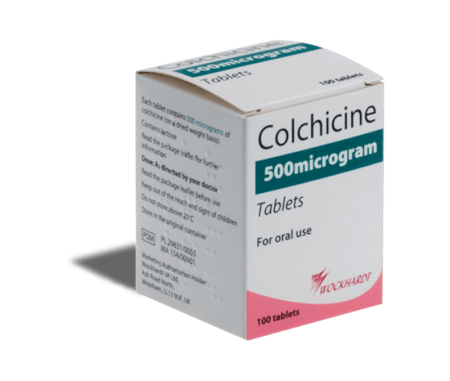- Home
- Chronic Conditions
- Gout Treatment
- Colchicine
Colchicine
Images for illustrative purposes only
Colchicine is a medication used to treat painful attacks of gout. Gout causes inflammation of the joints, particularly of the big toe. Colchicine is taken during a gout attack to reduce pain, inflammation and swelling.
- Effective gout treatment
- Relieves symptoms
- Works quickly
- Genuine medication
- Shipped from EU Pharmacies
More information
What is Colchicine?
- Colchicine is an anti-inflammatory medication taken during an attack of gout
- Colchicine should only be taken until the pain eases, or a maximum of 12 tablets per attack of gout
- Colchicine is sometimes known by its brand names Colcrys or Mitigare
- Colchicine can occasionally cause nausea (feeling sick) or diarrhoea
- You must not drink grapefruit juice or eat grapefruit whilst taking colchicine
- It is important to read the patient leaflet for a full list of side effects and cautions.
How Does Colchicine Work?
Colchicine is taken during an attack of gout. Gout is an inflammatory condition that causes a build-up of uric acid crystals in the joints. The joint most commonly affected by gout is the big toe. The crystals cause irritation that is extremely painful, and also cause swelling and inflammation.
Colchicine is an alternative to taking anti-inflammatory medications such as ibuprofen. Colchicine reduces the number of white blood cells that travel to the inflamed joint, helping to minimise the swelling and pain associated with gout.
How is Colchicine Taken?
Colchicine is a tablet that is swallowed with some water. Colchicine can be taken with or without food.
What is the proper dosage of Colchicine?
Colchicine 500mcg
1mg of colchicine (two tablets) is usually taken as the first dose, followed by 500mcg (1 tablet) an hour later. No more tablets should be taken for 12 hours.
12 hours after the initial doses, one 500mcg tablet can be taken every 8 hours until symptoms settle.
No more than 12 tablets (6mg) should be taken during a single attack of gout.
Are there any side effects to Colchicine?
Like all medications, colchicine can have some side effects. The most common side effects include:
- Nausea or vomiting (feeling sick or being sick)
- Tummy (abdominal) pain
- Diarrhoea.
If any of these side effects occur, stop taking colchicine and let the symptoms settle. If the side effects persist, you should speak to your doctor for advice.
If you have a severe allergic reaction (anaphylaxis) including breathlessness, lip or tongue swelling, call 999 immediately.
Does Colchicine come with any warnings?
Colchicine may not be suitable for everyone. You should tell your doctor if you:
- Have heart disease
- Have liver or kidney disease
- Have digestive problems
- Have a blood disorder
- Have ever had an allergic reaction to colchicine or any other medication
- Are pregnant, trying to conceive, or breastfeeding.
Some medications can interact with colchicine. You may be advised that colchicine will not suit you if you already take:
- Antibiotics
- Heart or blood pressure medications
- Medications for HIV
- Disulfiram (for alcohol abuse).
Grapefruit juice can increase the amount of colchicine in your blood. You should therefore avoid drinking grapefruit juice or eating grapefruit whilst taking colchicine.
Where can I buy Colchicine?
Buy Colchicine for Gout
You can safely buy Colchicine online at EU Meds. Because colchicine may not suit everyone, we will complete a Consultation with you including a health questionnaire. This will ensure that the medication will be suitable for you.
A qualified prescriber will review your current medications, including any herbal remedies or supplements, to ensure that colchicine will not interact with them.
Once prescribed, colchicine will be ordered on your behalf via electronic prescription, allowing you to pick the medication up at your convenience.
Buy Colchicine
Buying Colchicine Online
Can I buy Colchicine online?
You can safely buy Colchicine online at EU Meds. You will first need to have an online consultation with a pharmacist independent prescriber before your order will be supplied. The online consultation will ensure that Colchicine is the right medication for your medical condition.
Do I need a prescription for Colchicine?
Yes, in order to purchase Colchicine you will need a valid prescription. Please note, all requests for supply of prescription medications are subject to an online clinical consultation and the decision to prescribe will be made by a doctor.

Here to help you
Our Customer Service is available Monday to Friday 9am - 4pm. If you need urgent assistance, do not use this service. Call 111, or in an emergency call 999. Visit our help section



